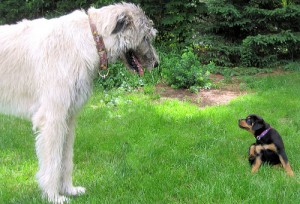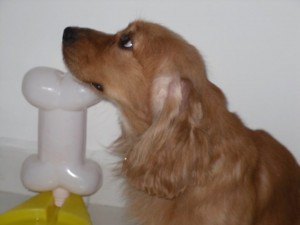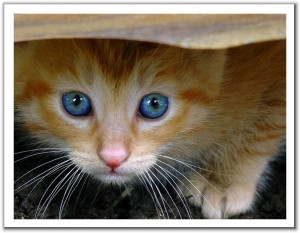The Importance of Good Dental Care for Pets
Thanks to all the new preventive medicine we can count on, our pets live longer, healthier lives, so much so that now some of the most severe medical issues pets can have are related to their dental health. Cleaning our pet’s teeth routinely can make a huge difference in their health and well being. By routinely, I mean daily, but don’t worry, once you get a hang of it, it shouldn’t take you more than a couple of minutes. Keep in mind, however, that even if you give them daily home cleaning, you should always take your pet to the vet at least once a year for a complete checkup, and if needed, a professional teeth cleaning.
Dogs and cats don’t get cavities often, if at all, but they do get gum disease and tartar can build-up excessively on the teeth. That is the main reason to provide good dental care. Plaque is formed when food particles and bacteria accumulate along the gumlines. If plaque is not removed in 2 to 5 days, it turns into tartar, which gets adhered to the teeth and it’s not as easy to remove. Tartar irritates the gums, and this is what causes gingivitis. You should check for reddening of the gums around the teeth and bad breath. Once tartar has developed, the cleaning should be done by your vet who can remove the tartar and polish the teeth. Once the tartar builds up under the gums, it causes a separation of the gums from the teeth and forms pockets, where even more bacteria can grow. At this point they have developed periodontal disease. Besides being very painful, this can cause tooth loss, abscesses and infections. As the bacteria increases, it can even reach the bloodstream, which can cause an infection of the liver, the kidneys, or the heart valves. Only your veterinarian can stop the advance or stop the disease.
So, what kind of dental care should you provide your pets?
Take your pet to the vet for regular checkups, which should include dental exams.
Have their teeth cleaned by the vet at least once, and then follow up with routine home dental care.
As I’ve said, your pet needs routine dental care at home, but for a good start, the teeth should be clean. If you’ve been taking care of their teeth since they were babies, maybe you are in good shape, but chances are you’ve neglected their teeth for a while. If they have already developed tartar, it would be important to have it removed by a vet. To perform a cleaning, your vet will anesthetize your pet, take x-rays, and proceed with the cleaning. The tartar will be removed from above and below the gumline. Then their teeth will be polished to remove any scratches caused by the cleaning to avoid accumulation of bacteria. Then the vet will tell you the best dental care program for your pet.
Now that their teeth are clean, you should start looking for warning signs in their mouths: bad breath, red and swollen gums, tartar around the gumline, and pain or bleeding when you touch the gums or mouth.
 Let’s start with the food. Kibble is definitely better for your pet’s dental health. Many foods have special properties to keep their teeth as clean as possible. There are also many treats you can give them that will aid in removing plaque and prevent tartar build up, as well as toys made especially to help in plaque removal.
Let’s start with the food. Kibble is definitely better for your pet’s dental health. Many foods have special properties to keep their teeth as clean as possible. There are also many treats you can give them that will aid in removing plaque and prevent tartar build up, as well as toys made especially to help in plaque removal.
Even when they eat the right kinds of food and play with the right toys, you need to brush their teeth every day. This is the most important preventive measure you can take.
How to brush your dog’s teeth:
First, you have to get him used to the process if you haven’t done it before. Start by gently massaging his teeth and gums for a few seconds and see how he reacts. If the fusses, don’t force him and try again the next day. In three or four tries, he should be more accustomed to your finger inside his mouth, so you can now progress to a brush. There are many types of brushes for dogs at your pet shop, and if it’s a small dog, you might try with a piece of sterile gauze. There are also special toothpastes for dogs with yummy tastes like chicken or liver. Never use human toothpaste! Pay attention to the big teeth in the back. Don’t worry too much about the inside, but pay special attention to the outside surface of the teeth. You can do a couple of teeth a day if he doesn’t like the process too much at first. Eventually, he’ll sit tight for the whole cleaning and you’ll be able to do it in a couple of minutes.
How to brush your cat’s teeth:
Again, you have to get you cat used to the feel of your finger in her mouth. Start just massaging her teeth and gums for a few seconds every day.  There are special brushes for cats, but using a piece of gauze is very effective. If the size of the cat will permit it, you can use one of those plastic “finger brushes” made especially for cats or dogs. I personally find them big for the size of my cats’ mouths. You also don’t have to worry too much about the inside, but do pay special attention to the outside surface of the teeth. Do get the flavored toothpaste in a yummy tuna flavor for them… or anything else they prefer. Your vet can also recommend a special sterile solution for cats. If you don’t have anything else handy, you can use a mix of baking soda and water, but very little. Never use human toothpaste! Of course, if you get your cat accustomed to her teeth cleaning when she’s a kitten, the work will be much easier, but you can get any cat used to this with patience and love. If you find it impossible, you will have to take her to a vet to have her teeth cleaned. Do not put this off!! There are places where they will do it for little money if you have financial difficulties. Just remember, they are dependent on you for their health.
There are special brushes for cats, but using a piece of gauze is very effective. If the size of the cat will permit it, you can use one of those plastic “finger brushes” made especially for cats or dogs. I personally find them big for the size of my cats’ mouths. You also don’t have to worry too much about the inside, but do pay special attention to the outside surface of the teeth. Do get the flavored toothpaste in a yummy tuna flavor for them… or anything else they prefer. Your vet can also recommend a special sterile solution for cats. If you don’t have anything else handy, you can use a mix of baking soda and water, but very little. Never use human toothpaste! Of course, if you get your cat accustomed to her teeth cleaning when she’s a kitten, the work will be much easier, but you can get any cat used to this with patience and love. If you find it impossible, you will have to take her to a vet to have her teeth cleaned. Do not put this off!! There are places where they will do it for little money if you have financial difficulties. Just remember, they are dependent on you for their health.
Photo Credits: greencolander
Pomeranians
 1.- Pomeranians can come in a variety of sizes. They can range from 2 to 30 pounds. The tiny sized dogs are the most popular, but since they are descendants of the German Spitz, sometimes they jump back to their ancestry even when coming from small sized parents.
1.- Pomeranians can come in a variety of sizes. They can range from 2 to 30 pounds. The tiny sized dogs are the most popular, but since they are descendants of the German Spitz, sometimes they jump back to their ancestry even when coming from small sized parents.
2.- They respond great to training, since they are super intelligent dogs that love to please their owners.
3.- They tend to bark a lot in response to any outside noise, so it’s important to let them know that barking once or twice when the doorbell rings is okay, but then they should stop.
4.- It’s very easy to spoil them since they are so cute and wonderful, but you should teach them to be independent so they don’t start suffering from separation anxiety or become clingy.
5.- They are surprisingly low maintenance despite their beautiful coats. They do need brushing, but their fur doesn’t normally tangle or get matted.
 6.- You have probably seen Pomeranians with funky haircuts, like Mohawks or the famous “Bear Cut”, however, keep in mind that once you cut or shave your Pom’s fur, it will never grow back as soft and beautiful. So make sure that’ s the look before you want for your dog before you take it to the groomer.
6.- You have probably seen Pomeranians with funky haircuts, like Mohawks or the famous “Bear Cut”, however, keep in mind that once you cut or shave your Pom’s fur, it will never grow back as soft and beautiful. So make sure that’ s the look before you want for your dog before you take it to the groomer.
7.- Some Poms don’t have as much undercoat as others, that’s why not all of them are as fluffy.
8.- You can find them with the little round face called “the bear face” or with a more elongates snout called “the fox face”. The fox face is the original, the bear face was developed for show as the breed shrunk.
9.- They come in so many different colors! White, black, brown, red, orange, cream, blue, sable, tan, merle, spotted, brindle, and every combination of these colors.
10.- They bond with their owners very quickly, however, as is the case with other small dogs, they are not the best for very small children.
Important to know
One good thing to know about Poms, is that they always go through their “puppy uglies” phase. All of a sudden the gorgeous coat disappears and they look like ugly ducklings. Relax, this passes at about 9 months, and they the fur grows out in it’s full splendour.
Photo of tiny Pomeranian courtesy of: Bluelight444
Chihuahuas
1.- There are two kinds of Chihuahuas: Apple head, with a short nose and round head, and Deer head, with a more elongated face.
 2.- They come long haired or short haired. The short haired has a smooth coat and sheds minimally. The long haired Chihuahua’s coat is silky, curly or flat.
2.- They come long haired or short haired. The short haired has a smooth coat and sheds minimally. The long haired Chihuahua’s coat is silky, curly or flat.
3.- They come in many colors: sand, black, fawn, white, black and white… and more.
4.- They are the tiniest dog breed.
5.- They do better with solid, dry food. Soft and canned food can promote dental problems.
6.- They are highly intelligent and can be hard to train. They require firm and gentle leadership.
7.- They gain weight easily, which can be very harmful to their health.
8.- They look very active at home, but that should not take the place of a good walk. When they are not walked often, they can present behavior problems.
9.- They can live from 14 to 19 years.
10.- They like to form ‘”clans” and will get along better with other Chihuahuas than other breeds.
They need to be very well socialized. If you allow them to be the pack leader, they’ll become possessive and even aggressive towards strangers. They can also be aggressive towards other dogs.
Though they are cute and tiny, they are not recommended for children.
Their temperament depends totally on how the owners treat them. If the owners are overly protective and baby them too much (which is the tendency) they will not be trustworthy pets. They can even become obnoxious.
Shelters tend to have large amounts of Chihuahuas. People tend to abandon them when they realize they are not the “toys” they hoped they would be. They represent a big responsibility.
Yes, their name comes from the Mexican State of Chihuahua, where they were discovered, but they date as far back as the 9th century AD and were found in the Aztec capital.
Long Haired Chihuahua Photo Courtesy of: Phoenix wolf-ray
Apple Head Chihuahua courtesy of: blackdood
Brittany Spaniels
 1.- Their long legs have the same length as their body.
1.- Their long legs have the same length as their body.
2.- The ones with black noses cannot compete in dog shows.
3.- It’s a very gentle, happy breed, great as a companion pet.
4.- They really need a pack leader. Their owner needs to be firm, but calm and confident.
5.- They are good for kids when they are raised with them from puppyhood .
6.- They don’t do very well in apartments. They are very active.
7.- They are very healthy dogs, although some are prone to hip dysplasia.
 8.- They have so much energy, they could be destructive if left alone.
8.- They have so much energy, they could be destructive if left alone.
9.- They like calm environments. They can get very stressed around loud voices and noise.
10.- They are very trainable and require lots of mental stimulation.
Important to know
They are prone to pee when they are exited or nervous.
They need to be very well socialized from puppyhood for them not to become fearful and shy.
If you are not willing to go running, hiking, swimming and have a very active lifestyle, this breed is not for you.
And no… despite their name, they have nothing to do with Great Britain. They come from the French province of Brittany.
Irish Wolfhound
 1.- They are huge. They are considered the tallest dogs, although once in a while a Great Dane will grow taller.
1.- They are huge. They are considered the tallest dogs, although once in a while a Great Dane will grow taller.
2.- They are very muscular and can reach the size of a small pony.
3.- They are hunting dogs, and two of their characteristics are speed and endurance.
4.- They are quiet and peaceful and make a very good family pet.
5.- They don’t have a soft coat. It’s wiry and rough.
6.- They can adapt to city living as long as they are exercised enough.
7.- They were feared in ancient Rome, where they would only be transported in cages.
8.- They are the oldest known breed of dogs.
9.- In the 19th Century, they were so costly that only royalty could own them.
10.- They will protect their family, but they don’t make very good guard dogs.
Important to know:
T hey should not be given supplements, a good food will suffice. This helps to slow down their rapid growth.
hey should not be given supplements, a good food will suffice. This helps to slow down their rapid growth.
They should not be exercised strenuously until they are 18 months old to avoid irreparable damage to their limbs.
They don’t live very long lives. Between 5 and 10 years. They are genetically predisposed to many ailments.
And yes… they were bred to hunt wolves.
What Makes Our Pets Itch
How awful it is when you get an itch in your back and you can’t get to it! Well, once in a while your dog or your cat needs to scratch an itch, and we have to investigate the reason why it is happening.
 What makes our pets itch? What causes itching skin on our dogs? An itch is a reaction to chemicals in the animal’s skin that makes him or her really want to scratch, and if you see your dog constantly scratching, it’s wise to find out what’s causing it. The itch can be triggered by anything from fleas and ticks, dry skin, allergies, bacterial infections, and even a serious disease, so it’s a good idea to look into it with the help of your vet. He or she will examine the pet and decide if more diagnostic tests are necessary. It might just be a matter of changing to special dog food for skin allergies or getting an anti itch dog shampoo. Treating them is important for your dog’s health. Cats can also have skin problems, but not as often as dogs do.
What makes our pets itch? What causes itching skin on our dogs? An itch is a reaction to chemicals in the animal’s skin that makes him or her really want to scratch, and if you see your dog constantly scratching, it’s wise to find out what’s causing it. The itch can be triggered by anything from fleas and ticks, dry skin, allergies, bacterial infections, and even a serious disease, so it’s a good idea to look into it with the help of your vet. He or she will examine the pet and decide if more diagnostic tests are necessary. It might just be a matter of changing to special dog food for skin allergies or getting an anti itch dog shampoo. Treating them is important for your dog’s health. Cats can also have skin problems, but not as often as dogs do.
Once your vet has ruled out any serious problems, here are some of the things you can do to help alleviate their itchy skin:
Check the food they’re eating. If you use commercial food, try to get a premium brand nutritionally balanced and give them a supplement of Omega-3 fatty acids. There are special supplements for dogs and cats, but you can give them the same fish oil you take. One 1000 mg. capsule once a day is enough. Use only half for small dogs and cats. If you are not comfortable giving such a large capsule especially to your dog, just puncture one end and mix it with some of his food. Do the same for small dogs and cats. If the taste or the smell is too much for them, you can always use some olive oil to coat their food.
Give them a bath, or at least, give the dog a bath. But make sure the water is not warm or hot. Cool water will give him some relief, but hot water will just make it worse. Use an oatmeal shampoo or one specially formulated for dry skin in dogs or cats. Also use a moisturizing rinse afterwards. Your vet might have given you a specific shampoo or conditioner to reduce any bacteria on the skin. When you’re done, pat him dry with a towel, don’t rub since this would just further irritate the skin. You can then use a skin tonic with herbal extracts to sooth the itch afterwards.
Treat them with oatmeal. Mix oatmeal and water, apply the paste to the irritated area and cover it with a warm towel to sooth the itch. If possible, try to keep your dog or cat calm for a little while for the soothing effect to work and repeat the process every day until there’s improvement.
You can also apply a few drops of vitamin E on the spot for relief. And remember to brush them frequently, since this releases the natural oils in the skin. But try to do it  very softly while the irritation still exists or avoid it altogether until it heals.
very softly while the irritation still exists or avoid it altogether until it heals.
Remember that you should always consult your vet before deciding on a natural remedy as a skin and coat treatment.
Some last tips:
If your vet determined that it’s an allergy, he might have prescribed antihistamines to control it, but make sure to watch your pet’s reaction. Some pets might get over excited, and others might get drowsy. This should help you decide whether to give it in the morning or late at night.
If the vet prescribed antibiotics to control a skin infection caused by so much scratching, make sure you give him the whole treatment and don’t miss any doses. An infection that is not well treated can be fatal.
Avoid fleas at all costs! Flea control is essential for your dog’s health and well being, and they can be a cause for the irritation that causes the scratching. If your cat is allowed to go outside, make sure you treat him too. There are many treatments to prevent and keep away fleas and ticks. Make sure you talk to your vet about it.
What to do when your pet has an itch to scratch
How awful it is when you get an itch in your back and you can’t get to it!Well, once in a while your dog or your cat needs to scratch an itch, and we have to investigate the reason why it is happening.
An itch is a reaction to chemicals in the animal’s skin that makes him or her really want to scratch, and if they’re scratching more than normal, it’s wise to find out what’s causing it. The itch can be triggered by anything from fleas and ticks, dry skin, allergies, bacterial infections, and even a serious disease, so it’s a good idea to look into it with the help of your vet. He or she will examine the pet and decide if more diagnostic tests are necessary.
Once your vet has ruled out any serious problems, here are some of the things you can do to help alleviate their itchy skin:
Check the food they’re eating. If you use commercial food, try to get a premium brand nutritionally balanced and give them a supplement of Omega-3 fatty acids. There are special supplements for dogs and cats, but you can give them the same fish oil you take. One 1000 mg. capsule once a day is enough. Use only half for small dogs and cats. If you are not comfortable giving such a large capsule especially to your dog, just puncture one end and mix it with some of his food. Do the same for small dogs and cats. If the taste or the smell is too much for them, you can always use some olive oil to coat their food.
Give them a bath, or at least, give the dog a bath. But make sure the water is not warm or hot. Cool water will give him some relief, but hot water will just make it worse. Use an oatmeal shampoo or one specially formulated for dry skin in dogs or cats. Also use a moisturizing rinse afterwards. Your vet might have given you a specific shampoo or conditioner to reduce any bacteria on the skin. When you’re done, pat him dry with a towel, don’t rub since this would just further irritate the skin. You can then use a skin tonic with herbal extracts to sooth the itch afterwards.
Treat them with oatmeal. Mix oatmeal and water, apply the paste to the irritated area and cover it with a warm towel to sooth the itch. If possible, try to keep your dog or cat calm for a little while for the soothing effect to work and repeat the process every day until there’s improvement.
You can also apply a few drops of vitamin E on the spot for relief. And remember to brush them frequently, since this releases the natural oils in the skin. But try to do it very softly while the irritation still exists or avoid it all together until it heals..
Remember that you should always consult your vet before deciding on a natural remedy as a skin and coat treatment.
Some more tips:
If your vet determined that it’s an allergy, he might have prescribed antihistamines to control it, but make sure to watch your pet’s reaction. Some pets might get over excited, and others might get drowsy. This should help you decide whether to give it in the morning or late at night.
If the vet prescribed antibiotics to control a skin infection caused by so much scratching, make sure you give him the whole treatment and don’t miss any doses. An infection that is not well treated can be fatal.
Avoid fleas at all costs! Flea control is essential for your dog’s health and well being, and they can be a cause for the irritation that causes the scratching. If your cat is allowed to go outside, make sure you treat him too. There are many treatments to prevent and keep away fleas and ticks. Make sure you talk to your vet about it.
How to Prevent Nasty Hairballs!
Watch any cat for a few minutes, and if he or she’s awake, you’ll see them grooming themselves with the help of their rough pink tongue. While this is a natural part of cat behavior, it is also the main cause of hairballs.
A hairball is just what it sounds like: a ball of hair. The technical term is trichobezoar. If you get hair in your mouth, you can just spit it out. But you cat can’t do that. Instead, she has to swallow the hair that comes off on her tongue during grooming. The bad news is hair can’t be digested.
Normally that’s not a problem either. The hair can still pass through the digestive tract and come out as part of the waste. However, sometimes the hair builds up in the stomach and can’t pass through the cat’s intestines. When that happens, the only way your cat can get rid of the nasty ball of hair is by throwing up!
Although seeing a cat vomit can be a disgusting and nauseating process to witness (the sounds alone make some pet owners gag), it’s better than the alternative. When your cat can’t throw up the hairball, they could end up with an obstruction that could be life-threatening and require surgery. Most feline owners would rather clean up a disgusting hairball then watch their beloved pets go under the knife.
But, thankfully, we have more options. We can actually prevent the formation of hairballs and reduce the risk of complications. Here are three tips that can help you help your cat.
Method #1: Reduce Excessive Hair
 When your cat is shedding a lot or needs a good brushing, he or she is more likely to develop hairballs that will need to be coughed up. You can help by spending time each day brushing your cat. Some cats love being brushed and will actually beg you to do it. Others aren’t crazy about being restrained and brushed so they are more resistant. But you can teach your cat to like getting groomed. Over time, even the most reluctant cat usually learns to love being brushed. Besides helping get rid of too much hair, regularly brushing reduces the amount of shedding your cat does (that’s good news for your furniture and clothes) and provides you with a great opportunity for bonding.
When your cat is shedding a lot or needs a good brushing, he or she is more likely to develop hairballs that will need to be coughed up. You can help by spending time each day brushing your cat. Some cats love being brushed and will actually beg you to do it. Others aren’t crazy about being restrained and brushed so they are more resistant. But you can teach your cat to like getting groomed. Over time, even the most reluctant cat usually learns to love being brushed. Besides helping get rid of too much hair, regularly brushing reduces the amount of shedding your cat does (that’s good news for your furniture and clothes) and provides you with a great opportunity for bonding.
Method #2: Give Special Treats as treatment
If you look at the treat section of your pet store, you’ll probably find some specially formulated treats designed to help break down hairballs in your cat’s stomach. Most of these treats come in delicious flavors – at least as far as your cat is concerned – so they eat them well. This might be a good idea if you notice your cat coughing up a lot of hairballs, or even just coughing without throwing anything up.
Method #3: Pass the Hairball
Sometimes a stubborn hairball can use a little help. Most pet stores also carry petroleum-based products that can be used to lubricate the cat’s hairball and intestines to make its passage easier. These products are 100% safe and come in cat-friendly flavors. Sometimes they can be added to the cat’s food.
A combination of all these methods can help control your cat’s hairball problem and can prevent life-threatening complications. And for you, the advantage is that you’ll spend more time grooming your cat, and less time cleaning up.
Safety Tips for Kids and Dogs
Children love dogs and dogs usually love children. When the two can interact safely and happily, it’s a beautiful thing to watch. Dogs can be wonderful friends and protectors for children while children can learn a great deal about how to be gentle, loving, and responsible dog owners. To reach that level and to gain those benefits, however, you’ll need to teach both the animal and the child how to safely interact.
Here are a few tips to make that happen.
Socialize the dog
A well-socialized dog is going to be less nervous and excited around children. You should start taking your dog or puppy to places where children will be present so they can get accustomed to the noise, the fast movements, and the heightened excitement. That can all be a lot for a dog and can cause him to become too excited or too nervous. If he is used to these things, he’ll be more likely to be calm when petted and adored by admiring children.
Teach your children
Children, as mentioned above, love dogs and sometimes they love them so much that they act without thinking. A little hand reaching tentatively to touch a dog’s head could easily get bitten by an unfriendly or poorly socialized dog. Children, for this reason, should always be taught to ask the dog’s owner before petting the animal. That gives the owner a chance to properly prepare the dog for the attention and to refuse if he or she knows the dog is not a big fan of children. Plus, it means your little one won’t be rushing up to dogs and putting themselves in a situation where a startled dog might attack.
 Teach the dog good manners
Teach the dog good manners
Just as children need to learn to ask before petting a strange dog, dogs should be taught good manners in public. If someone approaches him, the appropriate way to handle the attention is for him to sit or to lie down. This keeps the dog in a more controllable position for you and makes him see very well-behaved. Plus, if you take the time to sit the dog, the children can have time to calm down and the situation can be easier to manage. Also, you must teach your dogs, especially the larger ones, not to jump up on people as a greeting. This can be cute, but it is also very dangerous for children who can easily be knocked over by the weight of the dog.
Help children learn not to hurt animals
Sometimes children don’t understand the proper way to treat animals, including dogs. Kids may grab their tails or try to climb onto of them without thinking about the discomfort this could cause the dog. Small dogs can be injured, placed in toy boxes, or more. For the dog, these are negative experiences that make them dislike being around the child. As a parent, you should stop your children from engaging in these activities at the earliest sign of them. Teach your kids from day one how to treat the dogs appropriately. Also, be a good role model. If you hit your dog to punish him or her, you are sending a very dangerous message to your child.
The bottom line is that both dogs and children need a little bit of training in this area. They need to be socialized so they can get along with one another, and they need to learn the appropriate ways to respond to one another. With a little help, they can have a great relationship that is safe and loving.
When Does Your Dog Need to See a Vet
Some dog health issues must be addressed by a qualified veterinarian. Having a good vet in your corner, one who you know and trust is priceless and it’s very reassuring.
Flea Control and Worming:
Controlling fleas and worms is an important health issue that your Vet can assist you with. Fleas are an obvious problem, but there are also heartworms, tapeworms, roundworms… your vet will recommend a treatment to follow and you have to stick with it. You will probably need to administer monthly worming tablets (which they love!) and maybe other medication.
Annual Check Up:
It’s a good idea to schedule an annual check up or “wellness test”. Your Vet will conduct a series of tests which is a great proactive and preventive health measure. A good Vet will be able to spot any irregularities in the test results and will also check your dog for any sign of breed specific health problems. Educate yourself about dog diseases like Cushing’s and Addison’s. Sometimes these diseases sneak up on you and you don’t realize it until it’s too late and complicated to treat.
Vomit:
 If your dog vomits once, take certain precautions within your household to avoid it from happening again. However, if your dog frequently throws up, has chronic diarrhea, has bloody stools (bloody stools look like coffee grains), if the dog’s stomach is swollen, or if he has a fever or appears to be ill, you must call your veterinarian right away. Even if your dog doesn’t have these symptoms, but has been vomiting frequently, it’s very important to call the vet at once. Dogs can become quickly dehydrated and this can cause serious problems to their health. Frequent vomiting can indicate other serious health problems like gastroenteritis, gastric ulcers, tumors, or intestinal obstructions. Parasites can also cause a dog to vomit because they proliferate so rapidly that they can actually block the dog’s gastrointestinal track.
If your dog vomits once, take certain precautions within your household to avoid it from happening again. However, if your dog frequently throws up, has chronic diarrhea, has bloody stools (bloody stools look like coffee grains), if the dog’s stomach is swollen, or if he has a fever or appears to be ill, you must call your veterinarian right away. Even if your dog doesn’t have these symptoms, but has been vomiting frequently, it’s very important to call the vet at once. Dogs can become quickly dehydrated and this can cause serious problems to their health. Frequent vomiting can indicate other serious health problems like gastroenteritis, gastric ulcers, tumors, or intestinal obstructions. Parasites can also cause a dog to vomit because they proliferate so rapidly that they can actually block the dog’s gastrointestinal track.
Torn nail:
Dogs romp and stomp and have fun until they snag a nail. Then the howling and bleeding begin. See if you have a styptic pencil handy, or you can use corn starch if you don’t, to stop the bleeding and put a bandage on the injury and go to your vet. But if there is a lot of blood, a visit to the emergency room is the safest bet.
Insect bites or stings:
Sometimes you don’t even notice an insect bite on your dog, however, they can be very serious if the animal is hyper-sensitive or allergic. If left untreated, the dog’s breathing could become affected.
Eye trauma:
This is always an emergency. When an animal gets poked or scratched in the eye or has an eye infection, it likely will get worse without treatment.
By the way, don’t let your dog hang his head out the car window. They can get debris or bugs in their eyes. If your pup insists on having the breeze in his face, it’s a great excuse to train him to wear a pair of specially designed pet goggles.
Abrasions:
Clean the wound and protect the lesion with topical antibiotics and cover it with a bandage. But a lesion like that can cause your pet to lick or scratch excessively and lead to infection. Call your vet to get advice. Your pet could benefit from pain relief and might even need to wear an Elizabethan collar to protect the lesion… but don’t worry, there are alternatives to the dreaded collar.
Punctures:
Your dog may step on a nail, brush against a tree or get caught while climbing under a fence and could get a splinter or tear his or her skin.
Snake bite:
This isn’t a huge issue for a city dog, but if you travel or go camping with your pet, you have to think about it. When camping, check with park rangers to see if rattlesnakes (or other biting snakes) are in the area. Try to keep your pet as immobilized as possible to prevent the rapid spread of the venom, and take him or her to a vet.
Emergency!
In the unthinkable case of serious injury or illness, you will need a vet who you trust and can rely on to save your dog’s life. It helps if the vet is familiar with your dog. Do good research when choosing a vet. Consider one who is open long hours and has the ability to perform emergency surgery should the need arise.
Learning to Coexist With a Trouble Making Cat
Even the most ardent fan of the feline species has to admit that cats can be little trouble makers.
While dogs can cause quite a bit of mischief themselves, your cat’s intelligence, size, and nimbleness can help him or her cause more than a little bit of aggravation for you from time to time. But don’t worry. The two of you can learn to live a harmonious life. Here are some strategies that can help you when you have cat trouble.
Strategy #1: Learn Feline Nonverbal Communication
You’d be surprised how much easier your life would be if you simply understood the nonverbal communication messages your cat is sending your way. For example, if your cat has a habit of nipping you as you pet him, start watching for a few key signs, such as pinned back ears and a flicking tail. These are all signs that affection time is over. If you don’t take the subtle hints, your cat has to give you something you will notice: a nip with her tip. By stopping when you see these signs, you can end this problem for good.
Strategy #2: Appreciate the Value of Scratching
 While scratched up furniture might not be much of a value, your cat’s claws are valuable to her. She uses them to give her a sense of safety and to help her manipulate her environment. Sometimes your couch just gets in the way. The best way to stop these types of unwanted behaviors is to invest in a scratching post and rub some cat nip on it. This will encourage your cat to use the post and to leave your furniture alone. There are also special adhesive strips to avoid this problem. NEVER think of declawing. This surgery is cruel and unnecessary.
While scratched up furniture might not be much of a value, your cat’s claws are valuable to her. She uses them to give her a sense of safety and to help her manipulate her environment. Sometimes your couch just gets in the way. The best way to stop these types of unwanted behaviors is to invest in a scratching post and rub some cat nip on it. This will encourage your cat to use the post and to leave your furniture alone. There are also special adhesive strips to avoid this problem. NEVER think of declawing. This surgery is cruel and unnecessary.
Strategy #3: Learn Their Language
Cats are like human babies. An infant cries to get what it wants, but because the baby can’t articulate what it wants in a vocabulary we understand, fulfilling the child’s needs can sometimes be frustrating. That’s the way it is with cats and their meowing. Incessant meowing can, admittedly, be annoying, but it is not being done to make you go crazy or to make ear plug manufacturers wealthy. Your cat is trying to say, “I want this. Please give it to me.” As the human, you have to learn what “it” is. Sometimes it’s food, a change of litter, or affection. A non-spayed female will meow a great deal when she is ready to mate. Trial and error is the best approach. Just remain calm and remember the meowing is a cry for assistance and not a tool for torture.
Strategy #4: End Bad Digging
Cats enjoy digging – something you may have noticed. They use digging to cover up their waste in the litter box, but they will also go digging as a way to entertain themselves. Your cat might, for example, decide to dig up your garden or your houseplants. Be proactive. Go to the grocery store and buy some fresh citrus fruits. It doesn’t matter what kind you get. Cats aren’t font of anything citrus. Remove the rinds from the fruits and bury them in the soil where you do not want your cat to dig. This will work wonders. But it might be a good idea to give her a safe outlet for her digging passion, such as a small sandbox in your fenced in backyard or a pot of dirt of her very own.
in the litter box, but they will also go digging as a way to entertain themselves. Your cat might, for example, decide to dig up your garden or your houseplants. Be proactive. Go to the grocery store and buy some fresh citrus fruits. It doesn’t matter what kind you get. Cats aren’t font of anything citrus. Remove the rinds from the fruits and bury them in the soil where you do not want your cat to dig. This will work wonders. But it might be a good idea to give her a safe outlet for her digging passion, such as a small sandbox in your fenced in backyard or a pot of dirt of her very own.
Following some of these strategies can make living with your cat much more enjoyable for both of you.


